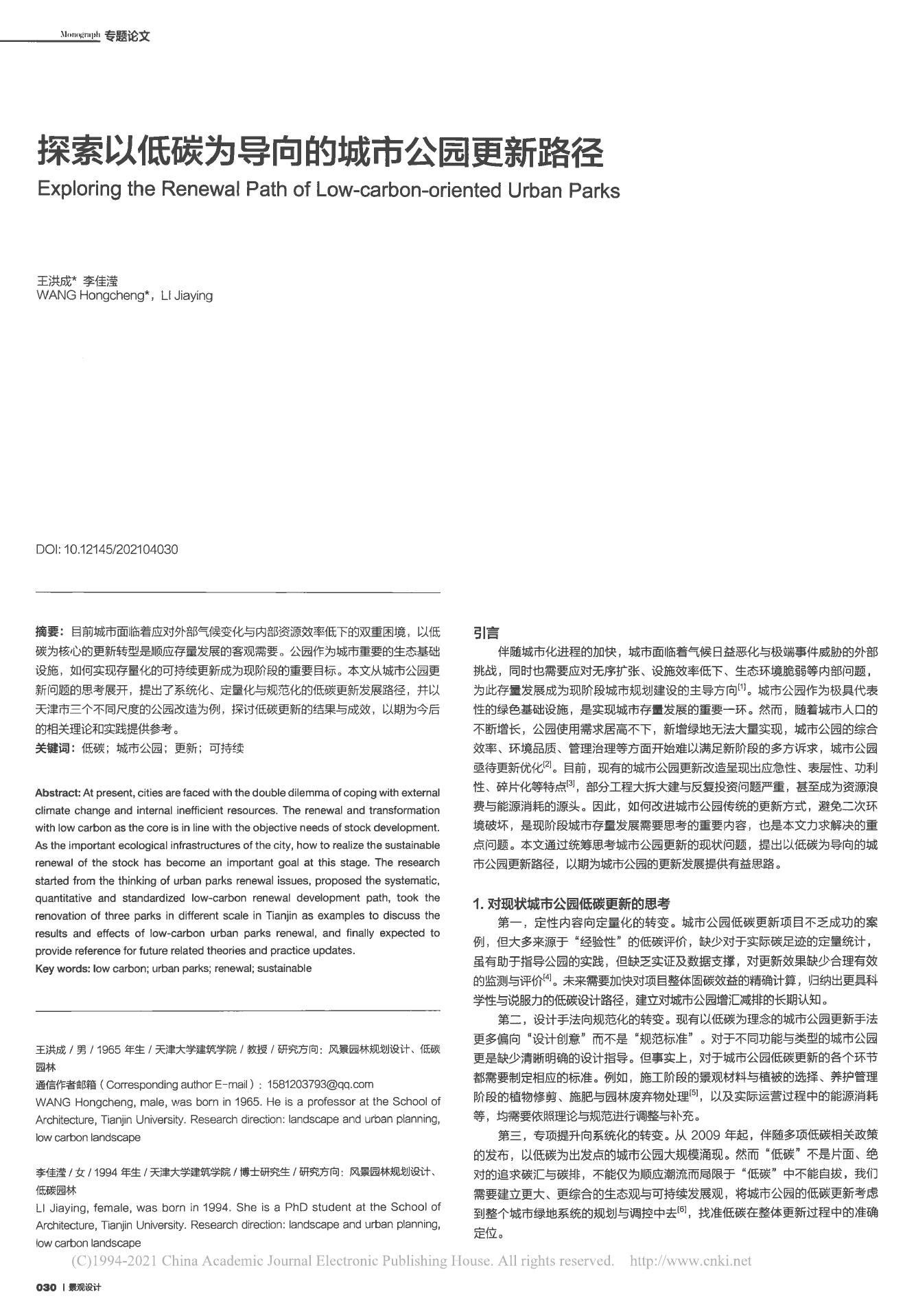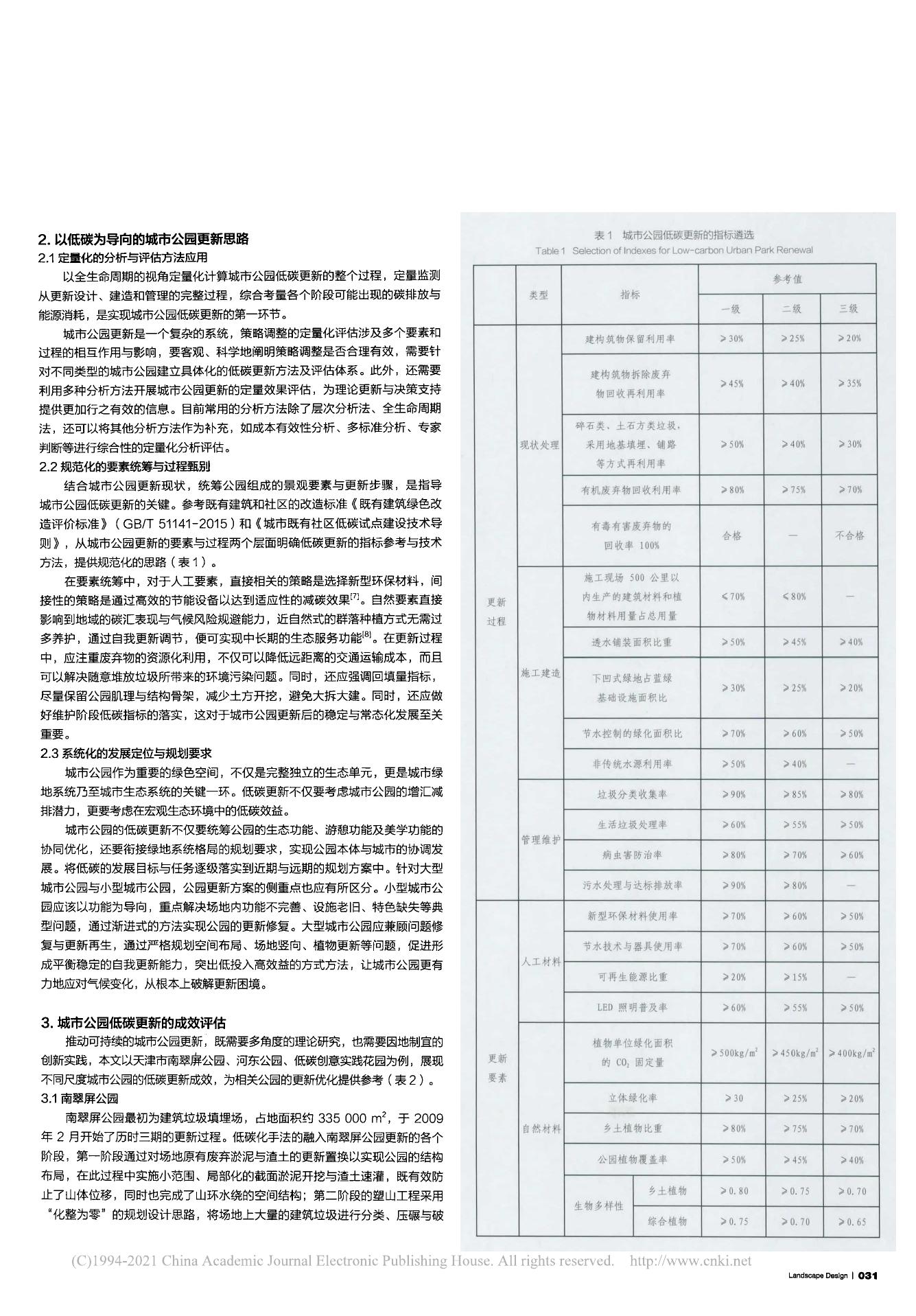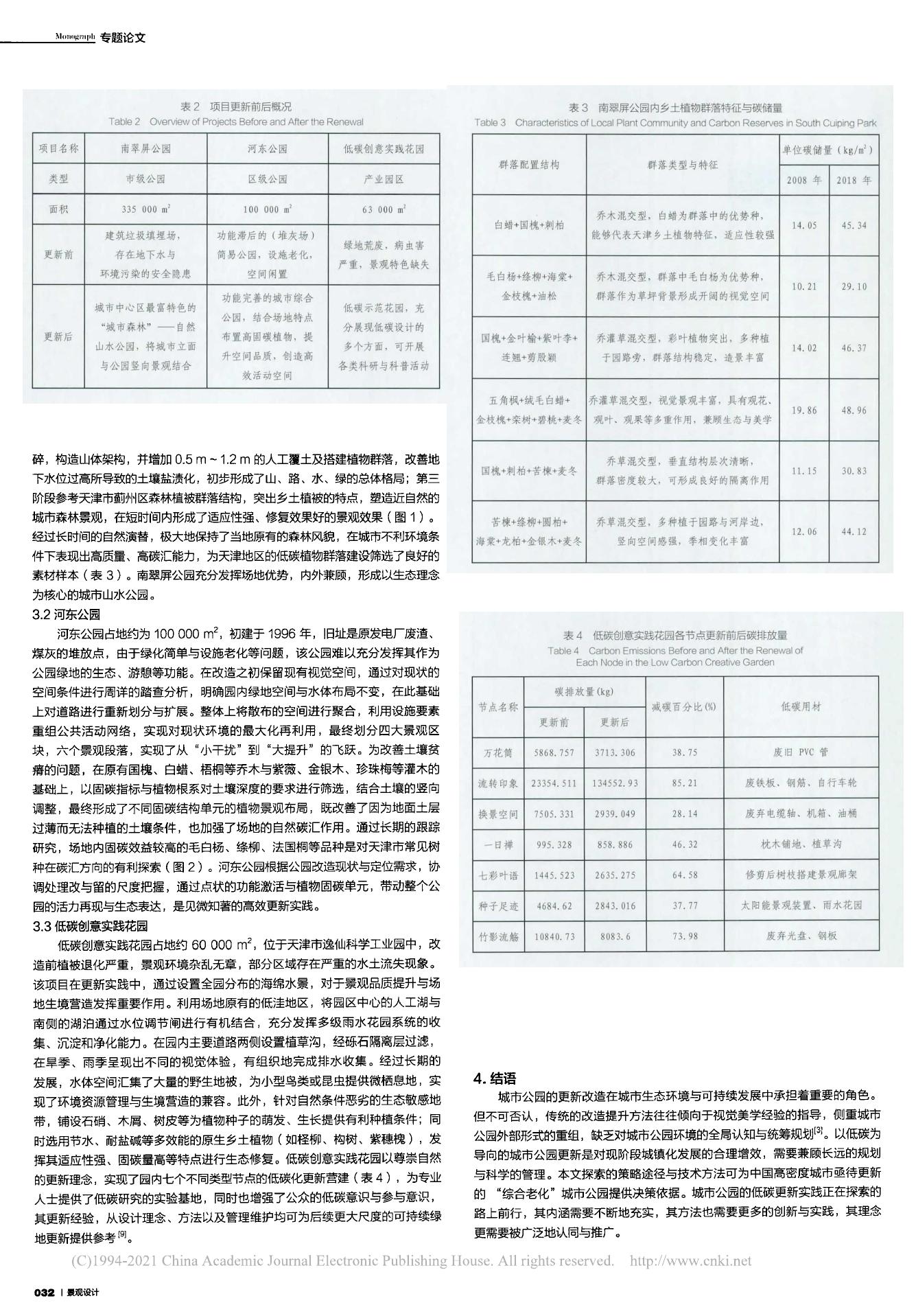
M
o
i
m
^nipli
专
题
论文
探
索
以
低
碳
为
导
向的
城
市
公
园
更
新
路
径
ExploringtheRene
w
alPathofLo
w
-
carbon
-
orientedUrbanParks
王
洪
成
*李佳滢
W
ANGHongcheng
*
,LIJiaying
DOI:10.12145/202104030
摘要:目前
城
市
面
临着 应 对外部气
候
变化与内部资 源效 率
低
下
的
双
重
困境,以低
碳
为核
心
的
更
新
转
型
是
顺
应
存
量
发
展
的客
观
需
要
。
公园作为
城市
重
要
的
生
态
基
础
设
施
,如何实
现
存
量
化
的
可
持
续
更
新
成为
现
阶段的
重
要
目
标
。
本
文从
城
市公园更
新问
题
的思
考
展
开
,
提
出
了
系
统
化
、
定
量
化
与
规
范
化的 低
破
更
新
发
展
路
径
,
并
以
天
津
市
三
个
不
同
尺
度的
公
园改
造
为
例
,探
讨
低
碳
更
新
的
结果
与
成
效
,以期为
今
后
的相关
理
论和实践提供参考。
关
键
词:
低
碳
;
城
市
公
园;
更
新
;
可
持 续
Abstrac t:Atpre s ent
,citiesarefaced
w
iththedoubledi l e
m
m
aofcoping
w
ithexternal
cli
m
atechangeandinternalinefficientresources.Therene
w
ala n dtransfor
m
ation
w
ithlo
w
carbonasthecoreisinline
w
iththeobje c tiveneedsofstockdevelop
m
ent.
Asthei
m
portantecol
o
gicalinfrastructure s ofthecity,ho
w
toreal i zethes u stainable
rene
w
alofthestockha s beco
m
eani
m
portantgo a latthisstage.Therese a rch
startedfro
m
t hethinkingofurbanparksrene
w
aliss u es,proposedthesyste
m
atic,
quantitativeandstandardizedlo
w
-
carbon
rene
w
aldevelop
m
entpath,to o kthe
re n ovationofthreeparksindifferentscaleinTianj
inasexa
m
plestodiscus s the
res ultsandeffectsoflo
w
-
carbon u rbanparksrene
w
al
,andfinallyexpectedto
provide r eferenceforfuturerelatedtheoriesandpracticeupdates.
Key
w
ords:lo
w
carbo n ;urbanparks
;rene
w
al
;sustainable
王
洪 成 /男/1965年
生
/
天
津
大学
建
筑
学 院 /教授 /
研
究方 向:
风
景
园
林
规
划设
计
、f氏碳
园
林
通
信
作
者
邮箱 (CorrespondingauthorE
m
ai l ):15812 0 379 3
@
qq.co
m
W
ANGHongcheng,
m
ale,
w
asbo
m
in 1 9 6 5.HeisaprofessorattheSchoolof
Archite c ture,Tianj
inUniv e rsity.Researchdirection:landscapea n durba n plan n ing,
lo
w
carbonlandsc a pe
李
佳
滢/女/1994年生/
天
津
大
学
建筑
学
院/
博
士
研
究
生
/
硏
究
方
向:
风
景 园
林规
划
设
计
、
低碳 园林
LIJiaying,fe
m
ale,
w
asbornin1994.SheisaPhDstudentattheSchoolof
Architecture,Tianj
inUniv e rsity.Researchdirection:lands c a pea n durbanplan n ing,
lo
w
cartjonlandsc a pe
引言
伴
随
城 市
化
进
程
的加
快
,
城
市
面
临着 气
候
日
益
恶
化
与
极 端
事
件
威
胁的
外
部
挑
战
,同时
也
需
要
应
对
无
序
扩
张
、
设
施
效
率低
下
、
生态
环
境
脆弱
等
内部问
题
,
为
此
存
霣
发
展
成为
现
阶
段
城
市规划建
设
的
主
导
方向[
1
1
。城市
公
园作为极
具
代 表
性
的
绿
色
基
础设施
,
是
实
现
城 市 存
屋
发
展
的
重
要
一
环
。
然
而
,随 着
城
市
人
口的
不
断增 长,公园使用
需
求
居
高
不
下
,新增绿
地
无法大
量
实
现
,
城
市
公
园的综合
效
率
、
环
境
品质、管
理
治
理
等 方
面
开
始
难
以
满
足
新
阶
段
的多方
诉
求
,
城
市
公
园
亟
待
更
新
优化
。目前,
现
有的
城
市公园
更
新 改
造
呈
现
出应急性
、
表
层
性、功利
性
、碎 片
化等
特
点
%
部
分
工
程
大
拆
大
建
与
反
复投资
问
题
严
重
,
甚
至
成
为资
源
浪
费
与
能
源
消
耗
的
源
头
。
因
此
,如 何 改进
城
市
公
园
传
统
的更新方
式
,
避
免
二
次
环
境
破
坏,
是
现
阶
段
城
市存
量
发
展 需
要
思
考
的
重
要
内容,
也
是
本
文
力
求
解 决 的
重
点
问
题
。本 文
通
过
统
筹
思
考城市
公
园更
新
的
现
状问
题
,
提
出以
低
拔
为
导
向的
城
市
公
园
更
新
路
径
,以期为
城
市
公
园的更新发
展
提
供有
益
思
路。
1.对
现
状城市
公
园低碳更新的思
考
第
一
,定 性 内容向定
量
化
的转变。城市公园低碳更
新
项目
不
乏
成 功 的案
例,
但
大
多来
源
于
“
经
验
性
”的
低碳
评
价
,
缺
少
对
于
实
际
碳
足
迹
的
定
量
统
计
,
虽有助
于
指
导
公
园的实践,但
缺
乏
实
证
及数 据 支撑,
对
更新效
果
缺少合
理
有效
的
监
测
与
评价[
4
]
。
未
来
需
要
加快对
项
目整体固
碳
效
益
的精确
计
算,归纳出更 具科
学性与说服力 的 低破
设
计路径,建
立
对
城
市公园增汇减排的长期
认
知
。
第
二
,
设
计
手
法
向
规
范
化
的
转变。
现
有以
低
破
为
理
念的
城市
公 园
更
新
手
法
更多 偏 向“
设
计创意”而
不
是1■规
范
标准”
。对
于
不
同功能与 类 型的城市公园
更
是
缺少 清晰明确的
设
计
指
导
。
但
事实
上
,
对
于
诚市
公
园
低
碳
更
新的 各
个
环
节
都
需
要
制定相
应
的标准 。例如,
施
工
阶
段
的
景 观
材料
与
植被的选择、养 护 管
理
阶
段
的植物修剪、
施
肥
与园林
废
弃 物 处
理
[5
1
,以
及
实
际运
营
过
程
中的能
源
消
耗
等,均
需
要
依
照
理
论
与
规
范
进行调
整
与补充。
第
三
,
专
项
提
升
向系
统
化
的
转
变
。
从
200 9
年
起,伴 随 多
项
低
碳
相关
政
策
的发布,以低碳为出发点的城市公园大
规
模涌现。然而“低碳”不是片面、绝
对
的
追 求
碳
汇
与
碳
排,
不
能 仅
为顺
应
潮
流
而
局
限
于
“
低碳
”
中
不
能自拔,
我
们
需
要
建
立
更大、
更
综合的
生
态
观
与
可
持续发展
观
,将城市公园的低碳更新考虑
到
整
个
城
市
绿
地
系
统
的规划
与
调
控中去[6
1
,
找
准
低
碳
在
整
体
更
新
过
程
中的准
确
定位。
0301
顧
谢
十



 VIP
VIP VIP
VIP VIP
VIP VIP
VIP VIP
VIP VIP
VIP VIP
VIP VIP
VIP VIP
VIP VIP
VIP